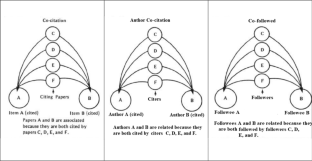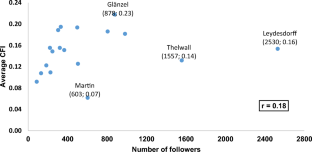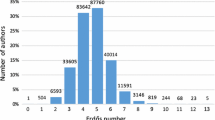Abstract
From the perspective of the ResearchGate community, the study examines what are the relationships among researchers described by the co-followers metric. The study used the ResearchGate accounts of 18 Solla Price medalists. From each researcher's account, the following indicators were retrieved: number of readings, number of recommendations, number of research items, number of followers, list of specialties, and the comprehensive list of followers' names. Pearson's correlation coefficients were calculated between number of followers and the other three indicators. Subsequently, a symmetric matrix was built with the number of common followers among the researchers, and then normalized by Salton's Cosine. Ucinet Software was employed to construct the relationship network among the Solla Price Medal winners with the MDS layout being adopted further for visualizing the proximity between them. The study found that the number of followers is a legitimate metric of academic reputation and impact on ResearchGate. The majority of followers of the analyzed Solla Price Medalists seem to choose to follow these researchers not because of their Solla Price Medal, but because of followers' familiarity with the researchers' scientific work and publications prior to joining ResearchGate. In addition, the clusters of medalists, according to their common followers, indicate that the groupings are strongly due to co-authorship in high-impact publications between the medalist researchers as well as their different specialties and the journals used to disseminate the results of their research projects. It is concluded that, instead of social proximities, the co-follower relational metric objectively represents theoretical-methodological proximities between researchers, as perceived by the ResearchGate community, providing a clear image of the role played by the researchers analyzed in this environment.


Source Elaborated by the authors

Source Elaborated by the authors

Source: Elaborated by the authors
Similar content being viewed by others
Notes
More recently, number of downloads and number of views have been combined into a single indicator: number of readings (Martin-Martin et al., 2018).
References
Ahlgren, P., Jarneving, B., & Rousseau, R. (2003). Requirements for a cocitation similarity measure, with special reference to Pearson’s correlation coefficient. Journal of the American Society for Information Science and Technology, 54(6), 550–560.
Bayer, A. E., Smart, J. C., & McLaughlin, G. W. (1990). Mapping intellectual structure of a scientific subfield through author cocitations. Journal of the American Society for Information Science (1986–1998), 41(6), 444.
Callon, M., Courtial, J.-P., & Penan, H. (1995). Cientometría. Ediciones TREA.
Costas, R., Perianes-Rodríguez, A., & Ruiz-Castillo, J. (2017). On the quest for currencies of science: Field “exchange rates” for citations and Mendeley readership. Aslib Journal of Information Management, 69(5), 557–575. https://doi.org/10.1108/AJIM-01-2017-0023
Desai, M., Mehta, R. G., & Rana, D. P. (2022). Anatomising the impact of ResearchGate followers and followings on influence identification. Journal of Information Science, 25, 9.
Garfield, E. (2001). From bibliographic coupling to co-citation analysis via algorithmic historio-bibliography: A citationist’s tribute to Belver C. Griffith. http://garfield.library.upenn.edu/papers/drexelbelvergriffith92001.pdf
Gilani, P., Bolat, E., Nordberg, D., & Wilkin, C. (2020). Mirror, mirror on the wall: Shifting leader–follower power dynamics in a social media context. Leadership, 16(3), 343–363. https://doi.org/10.1177/1742715019889817
Gmür, M. (2003). Co-citation analysis and the search for invisible colleges: A methodological evaluation. Scientometrics, 57(1), 27–57.
Grácio, M. C. C. (2020). Análises Relacionais de Citação para a identificação de domínios científicos: uma aplicação no campo dos Estudos Métricos da informação no Brasil. Cultura Acadêmica. https://doi.org/10.36311/2020.978-65-86546-12-5
Grácio, M. C. C., & Wolfram, D. (2019). Can anti-cocitations also measure author relatedness? In XVII International Society of Scientometrics and Informetrics Conference—ISSI (pp. 2648–2649), Sapienza University of Rome
Hilário, C. M., Delbianco, N. R. & Grácio, M. C. C. (2019). Indicadores cientométricos de impacto científico: um estudo comparativo entre a plataforma ResearchGate e a base Scopus. In VIII Seminário em Ciência da Informação – SECIN (pp. 158–172). UEL.
Hoffmann, C. P., Lutz, C., & Meckel, M. (2016). A relational altmetric? Network centrality on ResearchGate as an indicator of scientific impact. Journal of the Association for Information Science and Technology, 67(4), 765–775. https://doi.org/10.1002/asi.23423
ISSI. (2021). Derek de Solla price memorial medal. https://www.issi-society.org/awards/derek-de-solla-pricememorial-medal/
Kurtz, M. J., & Bollen, J. (2010). Usage bibliometrics. Annual Review of Information Science and Technology, 44(1), 1–64. https://doi.org/10.1002/aris.2010.1440440108
Lara-Navarra, P., López-Borrull, A., Sánchez-Navarro, J., & Yànez, P. (2018). Medición de la influencia de usuários en redes sociales: Propuesta social engagement. El Profesional De La Información (EPI), 27(4), 899–908. https://doi.org/10.3145/epi.2018.jul.18
Leydesdorff, L. (2005). The evaluation of research and the evolution of science indicators. Current Science, 89(9), 1510–1517.
Martin, B. R. (1996). The use of multiple indicators in the assessment of basic research. Scientometrics, 36(3), 343–362. https://doi.org/10.1007/BF02129599
Martín-Martín, A., Orduña-Malea, E., & Delgado López-Cózar, E. (2018). Author-level metrics in the new academic profile platforms: The online behaviour of the Bibliometrics community. Journal of Informetrics, 12(2), 494–509. https://doi.org/10.1016/j.joi.2018.04.001
Moed, H. F. (2000). Bibliometric indicators reflect publication and management strategies. Scientometrics, 47(2), 323–346. https://doi.org/10.1023/A:1005695111622
Moed, H. F. (2017). Applied evaluative informetrics. Springer International Publishing.
Moravcsik, M. J. (1988). Some contextual problems of science indicators. In A. F. J. Van Raan (Ed.), Handbook of quantitative studies of science and technology. New York: Elsevier Science Publishers.
Narin, F., Olivastro, D., & Stevens, K. A. (1994). Bibliometrics/theory, practice and problems. Evaluation Review, 18(1), 65–76. https://doi.org/10.1177/0193841X9401800107
Nicholas, D., Clark, D., & Herman, E. (2016). ResearchGate: Reputation uncovered. Learned Publishing, 29(3), 173–182. https://doi.org/10.1002/leap.1035
Orduña-Malea, E., Martín-Martín, A., Thelwall, M., & Delgado López-Cózar, E. (2017). Do ResearchGate Scores create ghost academic reputations? Scientometrics, 112(1), 443–460. https://doi.org/10.1007/s11192-017-2396-9
Priem, J., Taraborelli, D., Groth, P., & Neylon, C. (2010). Altmetrics: A manifesto. http://altmetrics.org/manifesto/
Researchgate. (2022a). About. https://www.researchgate.net/about
Researchgate. (2022b). Why we’re removing the RG Score (and what’s next). https://www.researchgate.net/researchgate-updates/removing-the-rg-score
Rostaing, H. (1996). La bibliométrie et ses techniques. Sciences de la Société.
Small, H. (1973). Co-citation in the scientific literature: A new measure of the relationship between two documents. Journal of the American Society for Information Science, 24, 265–269.
Smiraglia, R. P. (2007). A glimpse at knowledge organization in North America. Ko Knowledge Organization, 34(2), 69–71.
Smiraglia, R. P. (2009). Modulation and specialization in North American knowledge organization: Visualizing pioneers. NASKO, 2, 35–46.
Smiraglia, R. P. (2011). ISKO 11’s diverse bookshelf: An editorial. Ko Knowledge Organization, 38(3), 179–186.
Thelwall, M., & Kousha, K. (2015a). ResearchGate: Disseminating, communicating, and measuring Scholarship? Journal of the Association for Information Science and Technology, 66(5), 876–889. https://doi.org/10.1002/asi.23236
Thelwall, M., & Kousha, K. (2015b). Web indicators for research evaluation. Part 2: Social media metrics. Profesional De Lainformación, 24(5), 607–620. https://doi.org/10.3145/epi.2015.sep.09
Thelwall, M., & Kousha, K. (2017). ResearchGate articles: Age, discipline, audience size, and impact. Journal of the Association for Information Science and Technology, 68(2), 468–479. https://doi.org/10.1002/asi.23675
Vinkler, P. (1988). An attempt of surveying and classifying bibliometric indicators for scientometric purposes. Scientometrics, 13(5–6), 239–259. https://doi.org/10.1007/BF02019961
Vinkler, P. (2010). The evaluation of research by scientometric indicators. Chandos Pub.
White, H. D. (2001). Authors as citers over time. Journal of the American Society for Information Science and Technology, 52(2), 87–108. https://doi.org/10.1002/1097-4571(2000)9999:9999%3c::AID-ASI1542%3e3.0.CO;2-T
White, H. D. (2008). Katherine McCain: Recipient of the 2007 Derek de Solla Price Award of the journal Scientometrics. Scientometrics, 74(1), 7–10. https://doi.org/10.1007/s11192-008-0100-9
White, H. D., & Griffith, B. C. (1981). Author cocitation: A literature measure of intellectual structure. Journal of the American Society for Information Science, 32(3), 163–171.
White, H. D., & McCain, K. W. (1998). Visualizing a discipline: An author co-citation analysis of information science, 1972–1995. Journal of the American Society for Information Science, 49(4), 327–355.
Yan, W., Liu, Q., Chen, R., & Yi, S. (2020). Social networks formed by follower–followee relationships on academic social networking sites: An examination of corporation users. Scientometrics, 124(3), 2083–2101. https://doi.org/10.1007/s11192-020-03553-y
Yan, W., Zhang, Y., & Bromfield, W. (2018). Analyzing the follower–followee ratio to determine user characteristics and institutional participation differences among research universities on ResearchGate. Scientometrics, 115, 299–316. https://doi.org/10.1007/s11192-018-2637-6
Zhao, D., & Strotmann, A. (2014). The knowledge base and research front of information science 2006–2010: An author co-citation and bibliographic coupling analysis. Journal of the Association for Information Science and Technology, 65(5), 995–1006.
Acknowledgements
This research is funded by the Conselho Nacional de Desenvolvimento Científico e Tecnológico (CNPq) Grant No. 310785/2021-9. The doctoral dissertation of N.R.D. is funded by the Coordenação de Aperfeiçoamento de Pessoal de Nível Superior (CAPES) Grant No. 88887.687378/2022-00.
Author information
Authors and Affiliations
Corresponding author
Ethics declarations
Conflict of interest
The authors declare no conflict of interest.
Appendix
Appendix
See Table 3.Footnote 2, Footnote 3
Rights and permissions
Springer Nature or its licensor (e.g. a society or other partner) holds exclusive rights to this article under a publishing agreement with the author(s) or other rightsholder(s); author self-archiving of the accepted manuscript version of this article is solely governed by the terms of such publishing agreement and applicable law.
About this article
Cite this article
Grácio, M.C.C., Delbianco, N.R., Rosas, F.S. et al. Co-follower metric on academic-social media ResearchGate: similarities between Derek de Solla Price Memorial Medal winners. Scientometrics 128, 5545–5569 (2023). https://doi.org/10.1007/s11192-023-04793-4
Received:
Accepted:
Published:
Issue Date:
DOI: https://doi.org/10.1007/s11192-023-04793-4




